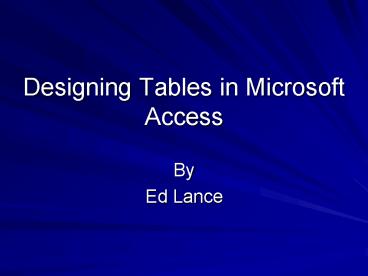Designing Tables in Microsoft Access - PowerPoint PPT Presentation
1 / 19
Title:
Designing Tables in Microsoft Access
Description:
Designing Tables in Microsoft Access By Ed Lance About Me Independent Database Consultant Worked with Access since 1.0 Many years designing, developing, tuning, and ... – PowerPoint PPT presentation
Number of Views:237
Avg rating:3.0/5.0
Title: Designing Tables in Microsoft Access
1
Designing Tables in Microsoft Access
- By
- Ed Lance
2
About Me
- Independent Database Consultant
- Worked with Access since 1.0
- Many years designing, developing, tuning, and
developing with databases. - SQL Server and .Net development consulting
- http//SanDiegoDataPro.com
3
Topics
- Introduction
- Creating Tables
- Setting up Relationships
4
Introduction
- This presentation will cover designing tables and
relationships in MS Access - Not covering concepts much (i.e. relational DB
theory I have slides on that). - Not covering linking external tables.
5
IMPORTANT!
- Tables and relationships are the foundation of
your Access application - Its vitally important that you get them properly
set up BEFORE you work on queries, forms or
reports. - Avoids road blocks and kludges
- Designing other objects goes faster in Access
- You need to have a working design, (normalized)
before you begin.
6
Creating a Table
- Several ways to start
- Datasheet View Just start entering data.
- Design View Usual way, gives you all the
properties - Table Wizard Can save some time if you have
common data, and help you learn - Tables can get created other ways as well Make
table queries, importing etc.
7
Table Design View
- Allows you to edit the structure of the table and
set properties for fields (columns) - Pic here
8
Adding Fields
- Enter Field Name, Data Type and Description
- Field Names can contain spaces
- Naming Conventions?
- Description is optional but is good for self
documenting applications. (Watch out, shows up
in status bar in forms!) - Setting Primary Key
9
Data Types
- Following data types are available
- Text Character data up to 255 chars
- Memo Up to 64K chars
- Number Integer and Float types
- Date/Time Dates and Time values
- Currency Currency values without rounding loss
- Autonumber Long Int., Access manages
- Yes/No bit value.
- OLE Object Binary objects, e.g. Word, Excel
docs - HyperLink 64000 chars, treated as hyperlink
10
Field Properties
- Properties in the General Tab
- Field Size Number of chars or size of numeric
type - Format How are those number displayed
- Input Mask For data entry
- Caption Used by form designer
- Default Value If nothing entered in field
- Validation Rule/Text validation expressions
- Required Dont allow Null values
- Allow Zero Length Allow in text fields
- Indexed Is this field indexed
- Others Unicode, IME, Smart Tags
11
Lookup Tab
- Allows you to set the default control that
displays the value. - Shows up everywhere.
- Can be overridden in forms reports
- For text and number, can use a combo or list box.
- For Yes/No, can use checkbox or combo box
12
Indexes
- An Index is like a hidden lookup table on one or
more fields. - Can have a huge impact on Select queries
- Can slow down inserts updates
- Deciding what fields to index is an art.
- At least get Primary Key and foreign keys
- Good naming makes this automatic
- An index can be on more than one field.
13
Indexes
- Index dialog
- Index Name, Field Name, Sort Order
- Properties
- Primary Is field part of primary key
- Unique Does the index enforce unique values
- Ignore Nulls Is Null considered a value?
- Changing index is changing table design, must
save table.
14
Relationships
- Very important!
- Setting relationships at design time on tables
means Access is responsible for referential
integrity, not you - Also, relationships are recognized automatically
when designing queries, forms, reports
15
Relationship Window
- Used to manage relationships and show
graphically. - Again, good naming helps you out.
- Window is also saves layout of itself, so it will
ask you to save.
16
Relationship Window
- Double-click relationship line to get properties
- Relationships can be more than one field.
- Referential Integrity
- Its a good thing
- Cascading Updates. Not an issue if you always
use Autonumber PKs - Cascading Deletes. Useful but dangerous.
17
Reviewing the Table
- After you are done making tables, open them all
up and check them out. - Subdatasheets. Do we need these?
- Print relationship window for documentation.
18
Design Tips (IMHO)
- Get table design down before you rush into it.
- Name the PK field the table name w/o prefix
(tblProducts ? ProductsID) - Name foreign keys same as the PK they join to.
- Always use Autonumber PKs (this started an
argument at a dev. convention) - Dont name fields reserved words.
- Use appropriate data types.
- Set relationships on tables, enforce referential
integrity. - Create indexes, but not too many. Watch for ones
Access creates that you didnt need.
19
Questions?

